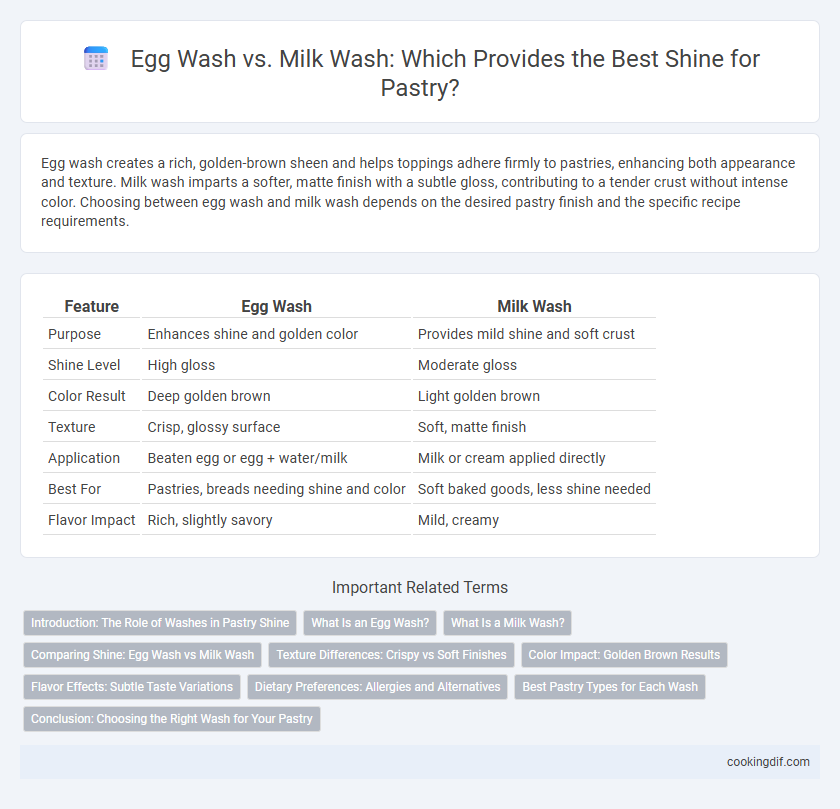Egg wash creates a rich, golden-brown sheen and helps toppings adhere firmly to pastries, enhancing both appearance and texture. Milk wash imparts a softer, matte finish with a subtle gloss, contributing to a tender crust without intense color. Choosing between egg wash and milk wash depends on the desired pastry finish and the specific recipe requirements.
Table of Comparison
| Feature | Egg Wash | Milk Wash |
|---|---|---|
| Purpose | Enhances shine and golden color | Provides mild shine and soft crust |
| Shine Level | High gloss | Moderate gloss |
| Color Result | Deep golden brown | Light golden brown |
| Texture | Crisp, glossy surface | Soft, matte finish |
| Application | Beaten egg or egg + water/milk | Milk or cream applied directly |
| Best For | Pastries, breads needing shine and color | Soft baked goods, less shine needed |
| Flavor Impact | Rich, slightly savory | Mild, creamy |
Introduction: The Role of Washes in Pastry Shine
Egg wash enhances pastry shine by creating a glossy, golden-brown finish through proteins and fats that caramelize during baking. In contrast, milk wash offers a softer shine with a more matte appearance, contributing subtle browning due to lactose sugars. The choice between egg wash and milk wash impacts the visual appeal and texture of pastries, making it essential for bakers to select based on desired crust characteristics.
What Is an Egg Wash?
An egg wash is a mixture of beaten eggs, sometimes combined with water or milk, brushed onto pastry surfaces before baking to create a glossy, golden finish. It enhances the appearance and texture by promoting browning through the proteins and fats in the egg, resulting in a more appealing and appetizing crust. Compared to milk wash, egg wash delivers a richer shine and stronger color, making it a preferred choice for pie crusts, croissants, and puff pastries.
What Is a Milk Wash?
A milk wash is a brushing technique using milk applied to pastry surfaces before baking to achieve a subtle golden-brown sheen. Compared to egg wash, milk wash provides a softer shine and a slightly tender crust without the intense gloss or color variations eggs create. This method is ideal for pastries requiring a gentle, uniform finish while enhancing flavor and texture delicately.
Comparing Shine: Egg Wash vs Milk Wash
Egg wash provides a richer, golden, and high-gloss finish on pastries due to its protein and fat content, making it ideal for achieving a visually appealing shine. Milk wash offers a subtler sheen with a softer, matte look and a light browning effect, perfect for delicate pastries that require less pronounced color. Choosing between egg wash and milk wash depends on the desired level of shine and crust texture for the pastry.
Texture Differences: Crispy vs Soft Finishes
Egg wash creates a glossy, golden-brown crust with a crisp texture due to its protein content that coagulates during baking. Milk wash imparts a softer, matte finish by adding moisture and sugars that caramelize gently without forming a hard crust. Choosing between egg wash and milk wash directly influences the pastry's surface texture, balancing between crispiness and tenderness.
Color Impact: Golden Brown Results
Egg wash creates a rich, deep golden brown color on pastries due to its protein and fat content, which caramelizes during baking and enhances surface shine. Milk wash produces a softer, lighter brown finish with subtle gloss, relying on lactose sugars for gentle browning. Choosing egg wash is ideal for achieving vibrant, glossy crusts, while milk wash suits pastries requiring a tender, matte appearance.
Flavor Effects: Subtle Taste Variations
Egg wash imparts a rich, savory flavor with a slightly golden, glossy finish that enhances the overall taste complexity of pastries. Milk wash offers a milder, slightly sweet flavor while providing a softer sheen and tender crust. Selecting between egg wash and milk wash depends on desired flavor depth and the specific pastry's texture profile.
Dietary Preferences: Allergies and Alternatives
Egg wash provides a rich, golden shine to pastries but may trigger allergies in individuals sensitive to eggs. Milk wash offers a milder gloss suitable for those avoiding eggs but can still cause reactions in dairy-intolerant individuals. Alternative options like plant-based milk or oil washes cater to vegan diets and common allergen concerns, ensuring safe and glossy pastry finishes.
Best Pastry Types for Each Wash
Egg wash, rich in protein and fat, creates a glossy, golden finish ideal for enriching puff pastry, croissants, and Danish pastries by enhancing browning and adding a slightly crisp texture. Milk wash imparts a softer sheen and subtle browning, making it better suited for tender pastries like brioche, sweet rolls, and scones where a gentle, warm color complements the delicate crumb. For flaky, layered pastries requiring a robust shine and shine durability, egg wash is optimal, while milk wash excels with soft, enriched doughs seeking a natural, understated glow.
Conclusion: Choosing the Right Wash for Your Pastry
Egg wash provides a glossy, golden finish that enhances the visual appeal and adds a slight crispiness to pastries, making it ideal for pies, croissants, and puff pastries. Milk wash yields a softer sheen with a subtle browning effect, perfect for softer baked goods like brioche or sweet rolls where a gentler finish is preferred. Selecting the right wash depends on the desired appearance and texture, with egg wash best for vibrant, crisp exteriors and milk wash suited for a tender, understated shine.
Egg wash vs Milk wash for pastry shine Infographic

 cookingdif.com
cookingdif.com